
1881
RAILWAY DOGS ON
THE BRIGHTON RAILWAY
THE RAILWAY REVIEW
10TH JUNE 1881
ANECDOTES OF RAILWAY DOGS
Few people who travel on the London, Brighton, and South Coast Railway now what a distinguished character has a free pass on every branch of the line, of which for several years he has taken daily advantage. It is between two and three years ago that a fox terrier, big in bone, and not over bred, jumped into a train that was leaving Brighton for Horsham, and settled himself in the guard's carriage. Little notice was taken of him at first, but after a time he began to be a person of great interest. No one knew where he came from, or whom he belonged; but every day he was ready for an early start in an early train. sometimes he went to Portsmouth, sometimes to Horsham, sometimes only to nearer stations' but most remarkable part of his arrangements was that he always got to Brighton in time to go by the last train to go by the last train to Lewes, where he always slept, leaving again by the first train in the morning. When the friend from whom the friend whom I first heard this story (and who vouches for the truth of it) last heard of Jack, he still continued this practice, and always spent the night at Lewes. About a year and a half ago the London, Brighton, and South Coast Company began to look upon him as one of their regular servants, and presented him with a collar bearing this inscription, "Jack L. B. and S. C. Railway Company." My. friend told me that one occasion, someone months ago, he traced Jack's movements on one especially day, and probably it was a good sample of many other. He arrived from Brighton by a train reaching Steyning at 10.50; there he got out for a minute, went on by the same train to Henfield. Here he left the train and went to a public house not far from the station, where a biscuit was given to him, and, after a little walk, took another train to West Grinstead, where he spent the afternoon, returning to Brighton to Brighton in time for the last train to Lewes. He was rather fond of the Portsmouth line, but never, I believe, has come so far as London. He generally takes his place on or by the guard's whee,. and sits looking out of the window. It would be very interesting to know in what the fascination of this perpetual railway travelling consists. It certainly shows an immense amount of instinct and observation, and the regularity and punctuality of Jack's daily life are a lesson to many a two legged traveller. Whether he considered himself sub-guard, or director, or general overseer, no one can tell, but there is, it seems, an idea of duty in his movements; what he has to do (or thinks he has to do) he does faithfully, and so far is a telling example to his fellow travellers on the London, Brighton, and South Coast Railway.
A correspondent writes to the Standard:-
"I was much amused with your account of this dog. I have known him four years, and can corroborate every word in the paragraph with one exception, and that is that Jack knows London Bridge and Victoria stations as well as I do, and especially the refreshment rooms. He has private apartments at Croydon, Three Bridges, Tunbridge Wells, and Eastbourne. The year before last Jack got into a North Western train by mistake, changed at Willesden, and went to Edinburgh with a guard he knew. He also goes to Dieppe occasionally. when he travelled with me he did not object riding first class, but it is seldom he will travel with anyone out of uniform."
See Sub page regarding Railway dogs
Right Jack the Railway Dog
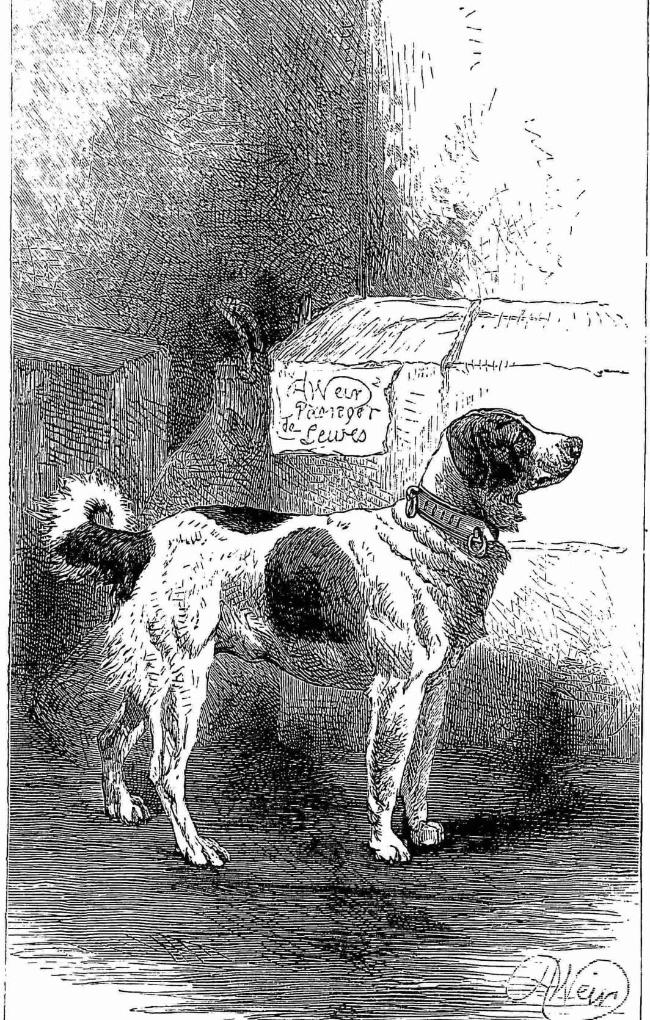
JACK THE RAILWAY DOG
Courtesy of Mick Symes
There have been many dogs over the years that have been associated with the railways, and
one such dog was well k dog was “Jack,” who was well known all over the L. B. & S. C.
Railway.
JACK THE RAILWAY DOG
August 1879
“Jack”the railway dog. Whilst waiting at the Horsham station on Friday night for the 9.20 up train, our attention was attracted by a little rough dog which scampered up the platform and leaped up on to the engine. On making home enquiries of the guard in charge go the trains to the meaning of this eccentric behaviour on the part of the annual, we were informed that he was known as “Jack” the railway dog, and was in the habit of constantly travelling on the Brighton line from Lewes via Brighton and Horsham to London, and vice versa, generally travelling on the engine in fine weather, and in wet weather hob-mobbing with the guards in their breaks. nobody knows to whom he belongs, and he takes the food given him by the railwaymen’s a matter of course as recognised for his company. Jack has thoroughly warmed himself into the affections of the engine drivers and guards, both of whom take the greatest interest in their canine passenger; and should Jack ever fail to put in an appearance on the starting of the trains usually patronised by him, many are the enquiries, “ here’s our little dog, Jack.”
E. REEVES COLLECTION
Jack the Railway Dog
July 18th 1885
December 1880
“Bob”, the once well known fireman’s dog, has a rival in “Jack” the railway dog. This
sagacious animal passes his time in railway trains, and is well known at Brighton, Lewes,
Hastings, London Bridge, and Peckham Rye. He travels with the guard, and take his repose at whatever terminus the train he happens to be in at night times arrives at. His taste lies
peculiarly in the direction of all things appertaining to railways, as he will take no notice of
any one not wearing a railway uniform.
A South London guard on one occasion took him home. Jack went peacefully enough, but
directly the man changed his clothes, and put on the garments of everyday life, Jack began to be uneasy, and at length bolted back to Peckham Rye. Jack is quite unoriginal in his way.
21 January 1882
Accident to “Jack,” the Railway Dog. On Friday morning a serious accident happened to
“Jack,” the London, Brighton, and South Coast Railway dog. He was crossing the up main
line at Norwood Junction station when the Brighton mail train came along, and before the
animal could reach the platform the engine caught him, and crushed his foot. A local
veterinary surgeon was at once summoned by the officials, and the dog’s injuries having been attended to, he was placed in the care of a guard of an Eastbourne goods trains, by whom he was handed over to his master. Mr. Moore, the station master at Lewes. The accident has since necessitated the amputation of one of the dog’s legs, a surgeon very successfully performing the operation while the animal was under the influence of chloroform.
No difficulty is anticipated as to Jack’s future locomotion on three legs, although the radius of his operations will be necessarily more limited. Hitherto it has been from Paris to Scotland.
The last previous appearance of Jack in Lewes was when had just returned from a wedding at Berwick, and he arrived gaily beckoned with ribbons in honour of the event.
THE RAILWAY REVIEW
20TH JANUARY 1882
Railway Jack. -- This well known dog has with accident which seemed likely at time to terminate his career. He had been absent from his home, Lewes station, about a fortnight, till brought back on Friday last with his fore leg crushed. It appears that Jack was at Norwood Junction late on the previous evening, and crossed the metals just as a fast train was running through. He missed his hold in jumping on the opposite platform, and fell under the engine. A surgeon has successfully amputated the limb close to the shoulder, the operation being performed while the animal was under the influence of chloroform. Although properly muzzled and every precaution taken to prevent Jack rubbing off his bandages, he succeeded in doing so during the temporary absence of his settlement for a few. The effect of this was rat severe secondary haemorrhage set in, and but for prompt attention the dog would have been dead in a few minutes. After this occurrence Jack was closely watched. No difficulty is anticipated as to Jack's future locomotion on three legs, although the radius of his operations will be necessary more limited. Hitherto it has been from Paris to Scotland. The last previous appearance of Jack in Lewes was when he had just returned from a wedding at Berwick, and arrived gaily bedecked with ribbons of honour of the event.
THE RAILWAY REVIEW
20TH JANUARY 1881
On old friend on the Brighton, dog "Jack," like many of his railway companions, has fallen a victim to the danger of the line. Crossing the line in front of a through express, am=nd missing his hold as he leaped to the platform, the engine and train passed over one of his legs. The damaged limb has been successfully amputated, and poor "Jack" is on a fair way to recover. In future he will probably be known as "three legged Jack," unless Mr. Stroudley or some other clever mechanical engineer can invent for him an artificial limb, as in the case of men, will perform some of the functions of the lost natural limb. Every kindness will be shown this four footed friend of the railways, though his decreased capacity for roving may induce him to appreciate more his home and master at Lewes
THE FATAL ACCIDENT AT THE RAILWAY STATION
The remains of the unfortunate young fellow Page (who died from injuries sustained in an accident on the goods station), were interred in St. John’s churchyard on Sunday afternoon. The funeral was attended by a large number of railway employees as well as of members of Court Lewes Castle A.O.F., of which the deceased was a member. “Railway Jack” was also present, wearing a crape collar.
The famous L. B. & S. C. Railway dog “Jack” has just reached Eastbourne station by one of the afternoon trains unexpectedly, and without guidance, otherwise than wonderful animal instinct to join in the procession of the funeral of Inspector Bryant, an official who had the honour of a large public burial. The noted dog just reached Eastbourne in time, found its way to the funeral, and solemnly followed the corpse to the cemetery, to the astonishment of everybody. The dog also joined the procession from the cemetery back again.
Railway Jack, the canine celebrity has just met with an accident which seemed likely to terminate his eccentric career. He had been absent from his home, Lewes Station, about a fortnight till brought back with his left foreleg crushed. Jack was at Norwood Junction late on the previous evening, and crossed the metals just as fast train was running through. He missed his hold in jumping on to the opposite platform, and fell under the engine of the approaching train. Jack’s left fore foot was completely crushed, and the radius servers fractured. The Norwood station master at once took him to a surgeon, who bound up the dog’s legal the same time expressing an opinion that the limb must either amputated or the animal killed. Mr. Moore, station superintendent at Lewes, was at once communicated with and the dog sent home. On arrival Jack was at once taken to Mr Stock, veterinary surgeon at Lewes, and, with the assistance of Mr. J.P. Braden, surgeon, he very successfully amputated the limb close to the shoulder, The operation was performed while the dog was under the influence of chloroform.
At a quarter past five their Royal Highnesses got back to station, where, at the especial quest of the Princess, Lady Brassey presented to her the famous “Railway Jack,” who had been sent on to Eastbourne from his home in the station master’s office at Lewes early in the day. The Princess, who had heard a great deal about the dog, was very glad to have this opportunity of seeing him, and she took away with her two photographs, one representing him seated up on a trunk before he lost his foreleg, the other taken since the accident, which has compelled him to a more sedentary existence.
November 1890
A famous dog, which had more than once had the honour of presentation to Royalty, died on Monday at the house of his master, Mr. F.G. Moore, Mayfield Sussex. Mr. Moore was
formerly stationmaster at Lewes, and his dog. “Railway Jack,” was known far and wide as a
traveller. He began by taking the train to Brighton and Newhaven, and then extended his
journey to London, Dover, and Canterbury, and after went as far afield as Exeter, Edinburgh, and Glasgow, but always returned to Lewes.
Once, at Eastbourne, the late Lady Brassey presented “Jack” to the Prince and Princess of
Wales, and he was introduced to Prince and Princess of Saxe Weimar at Cowes. He was a
great favourite everywhere, had three fine collars given him and a silver medal. “Jack” was
nearly thirteen when he ended his notable career.

JACK THE DOG
THE A.S.R.S. RAILWAY DOGS
THE RAILWAY REVIEW
10TH JUNE 1881
ANECDOTES OF RAILWAY DOGS
A passenger guard on the Brighton Railway has written the general office of the society suggesting the propriety of placing a collar on the neck of the dog "Jack," so well known on that line, calling attention to the Orphan Fund of the society, and that donations sent to 306, City Road, would be thankfully received. Since then, Mrs. Knight, the wife of the general manager of the line, has had a collar made to ornament Jack's shoulders and head, bearing the inscription, "I am Jack," and mentioning the name of the donor of the new adornment of the sagacious creature. Since then Mr. C.------*, the guard, has suggested that a rival to Jack should be trained, and be also ornamented with a collar, bearing some such inscription as following:- "I am Fred Evans (A.S.R.S. General Secretary), the Railwayman's dog. I live at 306, City Road, E.C., where my masters will thankfully receive donations for the orphan children of railway servants killed in the execution of their duties." The idea is an excellent one, and would do credit to the great Barnum's ingenuity in advertising. If the kind manager of the Brighton line raises no objections, we think that practical effect might be given to our friendly guard's suggestion. The one doubt we have is as to the proposed name to be given to Jack's rival. The General Secretary might object to being sometimes confounded with his namesake. Possibly, too, the dog would object to bearing the General Secretary's name, if sometimes he came in for expressions of ill-will intended for Mr. Evans, but inflicted on his canine namesake in default of ability or opportunity to inflict it on the man. The idea, however, deserves careful consideration in the interest of the Orphan Fund.
* Mr. John Climpson
HE RAILWAY REVIEW
16TH SEPTEMBER 1881
"FRED"
THE RAILWAY MEN'S DOG
We are glad to inform our readers that old railway servant has carefully selected a Colley bred dog, and presented it to the Society as a helper in collecting for the Orphan Fund. "Fred" is his name, and his home is at 306, City Road. His duties, which are already commenced, are to visit all railway termini in London, and advertise, by mean of a collar round his neck, the claims of the orphan children of the men killed on duty. The collar will shortly be provided, and will beat the following inscription:- "I am Fred, the railway dog of England, and travelling agent for the orphans of railwaymen who are killed on duty. My office is at 306, City Road, London, where my subscriptions will be thankfully received and duly acknowledged."
We hope that all railwaymen who meet with "Fred" will treat hime kindly, and if they cannot offer him a meal, they might always offer him "a drink." They can also bring "Fred" to the attention of the cause. "Fred" is as yet a youngster, only three months old, but has already travelled in Essex, Surrey, and Sussex, and succeeded in making many friends. As already stated, his home is at 306, City Road, E.C. Any railway servant who can arrange to call there for him, and take him for a day to any of the stations, or arrange for him performing a journey by train, will be doing a great service just now when "Fred" is in training. of course, it is excepted that any friend so acting will undertake to see the puppy returned home. The latest addition to the collectors for the Orphan Fund was duly christened on Monday morning, and takes very kindly to his name. We would just warn our friends that "Fred" is full of play, and just now delights in impressing the cloth of railway uniforms with his sharp, needle like teeth. Where he fancies corduroy as much as he does cloth remains to be proved. He is, however, mist docile and affectionate, and his love for railwaymen will be at once shown where any of the men leave their food or drink within reach when "Fred" rambles into any guard's or porter's room. When one undertakes to be the guest of another, it is usually understood that both are friends. Young "Fred" is ready; aye, and most anxious to become the guest of his mates on any railway in the kingdom. May we for the little orphans say, "If you love us, love our dog"? It is sincerely hoped that no objection will be raised by any higher officials to "Fred's" perambulations, and that he will be nowhere regarded as a trespasser.
THE RAILWAY REVIEW
2ND DECEMBER 1881
What has become of "Fred?" has been occasionally asked during the past five weeks. The youthful foot footed collector for the Orphan Fund is undergoing some little training near Newhaven where at the same time he is being "doctored" for a train accident sustained a few weeks since. The latest bulletin from his doctor says that "Fred" has nearly recovered from the accident, but exhibits symptoms of the canine measles, or distemper. When that infantine trouble is passed "Fred" will resume his duty as a collector, not of tickets and make up lost time. "Fred is getting a big boy now," and has attained to twenty four weeks ago. When full grown he will be well able to take care of himself on his journeys, and a creditable specimen of the genuine Colley breed. He is very affectionate, fond of railwaymen themselves, but more fond of the victuals sometimes found in their overcoats and mess rooms.
THE RAILWAY REVIEW
16TH DECEMBER 1881
We regret to announce the premature death of dog "Fred." The loss is a great one to the Orphan Fund, as "Fred" had already Brough in over £12 for the fund, though laid up during the past five months. The kindly guard who presented "Fred" to the society is determined to obtain another canine collector for the Orphan Fund. Every possible attention and kindness was shown to "Fred" during his illness by his trainer, who is a respected official of the Brighton Line.
THE RAILWAY REVIEW
30TH DECEMBER 1881
We are pleased to be able to announce that a successor to Dog Fred, whose days were so sadly ended, has now bee provided. he is undergoing a carful training, and in a short time will be ready to continue the work of collecting for the Orphan Fund, so well begun by his predecessor. Let us hope that he may be more fortunate, and live some years to carry out the work to which he has been devoted.
THE RAILWAY REVIEW
17TH MARCH 1882
The dog collectors for the Orphan Fund, respectively "Fred" and "Fred the Second," have a successor on the way from Scotland. "Fred the Third" is a full grown black and white collie, of amiable temper and affectionate disposition. He has survived the infantile afflictions that proved fatal to his predecessors, and we heartily welcome him to what we trust will be a long career of usefulness.
THE RAILWAY REVIEW
24TH MARCH 1882
OUR DOG COLLECTOR
The unfortunate dog friends of the orphans who died in youth, after much service, have a successor in a noble Scotch collie named "Help." "Help" is a fine specimen of "next to man, man's most faithful friend." The society has become possessed of him through the kindness of several friends. Mr. R.S. Moss, of the firm of Messrs. James S. virtue, took the initiative on seeing how downcast was Mr. J. Climpson, the Brighton guard (who presented the two former dogs to the Orphan Fund) at the loss of "Fred the Second." Mr. Moss volunteered his help in obtaining another collie, and on mentioning the matter to Mr. Isbister, the editor of the Sunday Magazine, the latter gentleman took an immediate interest in the matter, and wrote to his friend the Rev. Dr. Macleod, the editor of Good Words. In time the venerable doctor was struck with the good purpose for which a dog was required, and made inquiries among friends and through his daughter in the sheep districts of Pebble. In the result Mr. Wm. Riddell, of Dawyk, Stobo, very generously proffered his good dog "Help" as a present to the Orphan Fund. In a letter addressed to Mr. Evans, the donor touchingly alludes to his canine companion, and unknowingly shows the gift to be no ordinary one, for"Help" is a companion to him and the playfellow of his children. Mr. Riddell's letter is as follows:-
"I have now much pleasure in presenting to your excellent society my collie dog 'Help.' This has hitherto been his name, and it seems quite a suitable one for his new duties, but you can change it to 'Fred' or not as you think best. He is a genuine collie -- the very fact-smile of Robert Burns's Luath.
'His honest sonsie bows'nt face,
Aye gat him friends in ilka place.
His breast was white, his towzie back,
Weel clad in coat of glossy black;
His gangue tail wi' upward curl,
Hung o'ver his hurdies wi a swirl.'
He is a gentle creature; my children take all manner of liberties with him, and are only reconciled to parting with their playfellow by the assurance that 'Help' is going to work for the welfare of little fatherless bairnies. I hope he will be very successful in his mission."
Every right hearted railwaymen will, we are assured, feel thankful to Mr. Riddell and to his children for a gift which has surely cost the childlike hearts of the latter many a pang of sorrow in parting with so dear and faithful a friend. When, then, they see "Help," and remember that his children parted with him that he might help to get bread for other children who have lost their bread winners -- that he is the children's gift to the orphan children -- they will regard the dog with kindness, and be gentle to him. His mission is a blessed one, and we believe "Help" will find a corner of the society will look on "Help" as more than an ordinary dumb creature, In his dumb way he will be a co-worker with them in appealing to help for the orphans, and entitled to their care and affection. It is Mr. Evans's intention to take "Help" with him to the several towns he is advertised to address meetings at. Railwaymen may look out to make the acquaintance of their new friend.
THE RAILWAY REVIEW
4TH APRIL 1882
"Help," the dog collector, is established as a favourite with the children in households where The Railway Review is read. One friend writes to say that "When little Hattie and little May heard their father read about 'Help' from The Railway Review, they questioned him as to what a dog could want with money. When told that 'Help' wanted money for the fatherless children of railwaymen, they both declared that they would save all their pence for 'Help.' The good resolution of the little maidens will, we fear, he tested when the tempting sweets and toys in shop windows catch their eyes, and some of the pence promised to 'Help' will then probably go in another direction. Yet if Hattie and May occasionally think of 'Help's' mission, and are followed by other little girls and boys who have pleasant homes, a great deal can be done in the course of the year. Perhaps some fathers and mothers among our readers will encourage their children in making tiny sacrifices for other children who have no fathers, and thus assist "Help" to be the great help to bairpies which his former friends hope he will be.
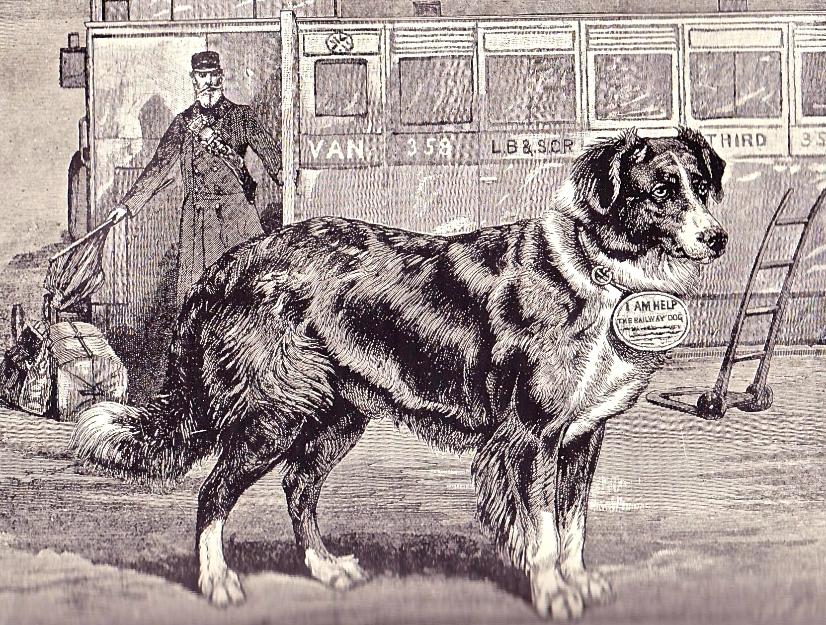
NATIONAL UNION OF RAILWAYMEN COLLECTION
Help the "Noble Railway Dog"
A faithful and clever animal formerly known to many passenger on the London and Brighton the tidal train between London Bridge and Newhaven for the Dieppe steam boats.
This photo was taken from the book tittle is 50 years of Railway Trade Unionism,
the story of the N.U.R. published in c1920
The first railway dog can be traced back to 1881, he was called “Fred” and collected
money for the “Orphan Fund” of the Amalgamated Society of Railway Servants of England, Ireland, Scotland and Wales. Unfortunately Fred had a ver
This famous dog, a pure Scotch Collie was a gentle and beautiful creature. He was
recognised as the “Railway Dog of England,” and was a most successful commercial
traveller on behalf of the Railway Servants Orphan Fund.
During his life he collected £1004. (1882 -1891). Mr. John Climpson, a Brighton passenger guard of the evening tidal boat train from London Bridge to Newhaven on the London Brighton and South Coast Railway for close on forty years, conceived the idea of training a dog for collecting purpose, and to carry an innovation for money to be given by the the passengers and others in aid of the Orphan Fund. “Help” was supplied through the agency of the Rev. Dr. Norman Macleod, by the assistance of Mr. W. Riddell, of Hailes, Haddington, procured a suitable dog for the service; indeed, the animal was a gift from Mr. Riddell, and Help was admirably suited for the work.
After being trained by Mr. John Climpson, “Help” travelled extensively from 1882 until 1891 throughout England, Scotland, Ireland and Wales and twice crossed the channel to France.
He carried a handsome silver collar, bearing a handsome silver Medal endorsed “I am Help the railway dog of England, and travelling agent for the orphans railwaymen who are killed on duty” plus “My office is at 55, Colebrook Row, London, where subscriptions will be thankfully received and duly acknowledged,” to which interested persons could send donations.
At the Bristol dog Show in 1884 “Help” was presented with a silver medal, and Mr. F.W. Hughes of the Gresham Club, present him with a silver collar and tablet. Help died in Newhaven in 1891. During his life Help raised over £1,000.
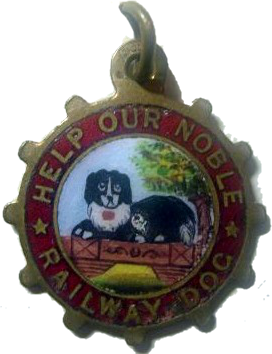
PHOTOGRAPHER UNKNOWN
Above is the rear of an Amalgamated Society of Railway Servants (A.S.R.S.) fob, which features the “Railway Dog”.
This fob/badge is extremely rare and is over 140 years old.
The amalgamation in 1923 of the London South Western with the London Brighton and South Coast and the South Eastern and Chatham Railways extended the area for fund raising, but at the same time increased the number of children requiring help and care, and by now dogs were collecting at all London Termini and large stations down the Thames to Dover, then round the coast to Plymouth and beyond.
Courtesy of Steve West

PHOTOGRAPHER UNKNOWN
Help is reproduced from a capital lithograph executed by the Newcastle artist,
Mr. Wilson Hepple

Brighton Bob mixed with commuters,
sometimes boarding trains on their own to encourage more giving by passengers. He barked, “ hook hands” and performed tricks for money, their exploits frequently reported in the national and regional press.
Brighton Bob could be a bit dishonest, he
collect coins in his mouth and gave them in, but secure boxes had to be tied to him
after a journalist for a Christian magazine
discovered in the 1860s that Brighton Bob was using some of his money to buy
biscuits at a bakery.
Railway dogs, were usually looked after and trained by railway staff and proved popular and lucrative.
Information extract & adapted from the
Old Southeronians Association Website
Which was written
By H.T. Hunt
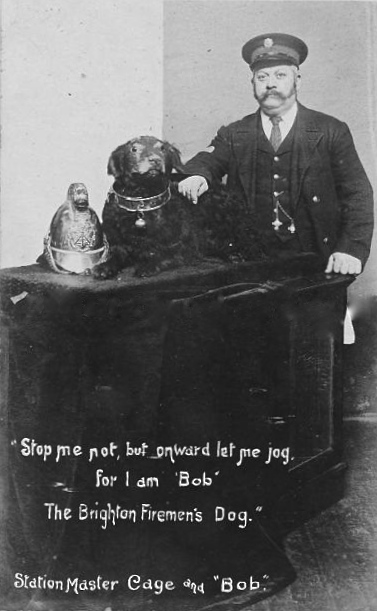
PHOTOGRAPHER UNKNOWN
Station Master Gage with Bob the Railway Dog
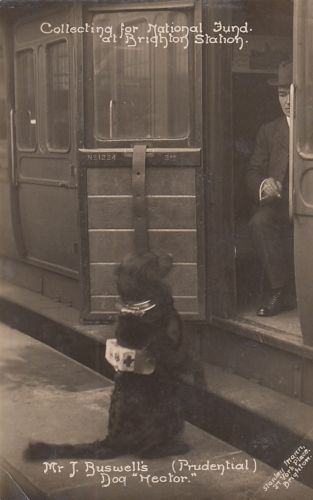
PHOTOGRAPHER UNKNOWN
Brighton Railway Dog ‘Hector’ & National Fund C1914
